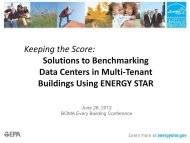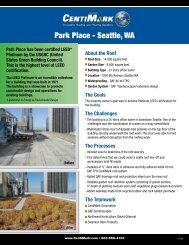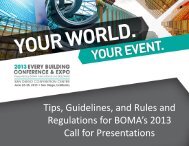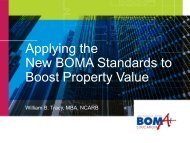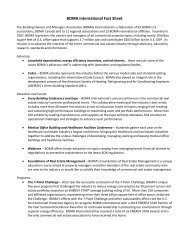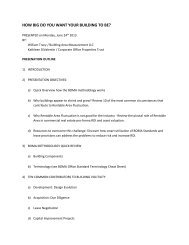PPT Presentation - BOMA
PPT Presentation - BOMA
PPT Presentation - BOMA
You also want an ePaper? Increase the reach of your titles
YUMPU automatically turns print PDFs into web optimized ePapers that Google loves.
LEED EB Recertification<br />
A Case Study of Lessons Learned<br />
<strong>BOMA</strong> International Conference<br />
June 23, 2013
Presenters<br />
Melissa Jones, LEED AP O+M<br />
Program Manager, Global Energy & Sustainability<br />
CBRE<br />
Aliza Skolnik, CEM, LEED AP, GGP<br />
Senior Associate<br />
Environmental Systems Design, Inc.<br />
Jordan Daniels, LEED AP<br />
Sustainability Manager<br />
LP Consulting Engineers, Inc.<br />
CB Richard Ellis | Page 2
Agenda<br />
► Recertification Timeline<br />
► Establishment vs. Performance<br />
► Energy & LEED EB Recertification<br />
► Case Study Examples<br />
► Recommendations to Implement<br />
CB Richard Ellis | Page 3
CB Richard Ellis | Page 4<br />
Recertification Timeline
Recertification Timeline<br />
INITIAL PERFORMANCE<br />
PERIOD<br />
April 1, 2009 – June 30, 2009<br />
NEW CREDIT PERFORMANCE<br />
PERIOD START<br />
Credits not initially applied for<br />
require full 3 month<br />
performance period ending with<br />
all recertification credits<br />
2009 2010 2011 2012 2013<br />
2014<br />
CERTIFICATION DATE<br />
Project achieved Certification<br />
on January 7, 2010<br />
MOST RECENT 25% OF PERFORMANCE<br />
PERIOD<br />
Documentation for most credits is<br />
required for most recent 25% of the<br />
recertification performance period<br />
CERTIFICATION EXPIRATION<br />
DATE<br />
Certification expires 5 years<br />
from end of initial performanc<br />
period – June 2014<br />
CB Richard Ellis | Page 5
LEED Rating Systems<br />
Calculating 25%<br />
5 Year Recertification Performance Period<br />
Recertification Performance Period<br />
June 1, 2009 – June 1, 2014<br />
12 months x 5 years = 60 months<br />
60 months x 25% = 15 months<br />
June 1, 2014 – 15 months = March 1, 2013<br />
CB Richard Ellis | Page 6
CB Richard Ellis | Page 7<br />
Establishment vs. Performance
Establishment vs. Performance<br />
Establishment Performance -<br />
25% Tracking<br />
Sustainable Sites:<br />
Credit 7.1<br />
Credit 8<br />
Water Efficiency:<br />
Prerequisite 1<br />
Credit 2<br />
Credit 4.1<br />
Energy & Atmosphere:<br />
Prerequisite 1<br />
Prerequisite 3<br />
Materials & Resources:<br />
Prerequisite 1<br />
Prerequisite 2<br />
Indoor Environmental Quality:<br />
Prerequisite 2<br />
Prerequisite 3<br />
Credit 1.2<br />
Credit 2.4<br />
Credit 3.1<br />
Credit 3.5<br />
Sustainable Sites:<br />
Credit 2<br />
Credit 3<br />
Water Efficiency:<br />
Credit 3<br />
Credit 4.2<br />
Energy & Atmosphere:<br />
Credit 3.1<br />
Credit 3.2<br />
Materials & Resources:<br />
Credit 1<br />
Credit 4<br />
Credit 5<br />
Credit 7<br />
Credit 8<br />
Indoor Environmental Quality:<br />
Credit 3.3<br />
Credit 3.6<br />
Performance -<br />
100% Tracking<br />
Sustainable Sites:<br />
Credit 1<br />
Water Efficiency:<br />
Credit 1.1-1.2<br />
Energy & Atmosphere:<br />
Prerequisite 2/Credit 1<br />
Credit 2.2<br />
Credit 2.3<br />
Credit 4<br />
Credit 5<br />
Credit 6<br />
Materials & Resources:<br />
Credit 2.1-2.2<br />
Credit 3<br />
Credit 9<br />
Indoor Environmental Quality:<br />
Credit 1.5<br />
Credit 2.3<br />
Credit 3.4<br />
Performance –<br />
Reoccurring Events<br />
Sustainable Sites:<br />
Credit 4<br />
Credit 5<br />
Credit 6<br />
Credit 7.2<br />
Water Efficiency:<br />
Energy & Atmosphere:<br />
Prerequisite 3*<br />
Credit 2.1<br />
Materials & Resources:<br />
Credit 6<br />
Indoor Environmental Quality:<br />
Prerequisite 1<br />
Credit 1.1<br />
Credit 1.3<br />
Credit 1.4<br />
Credit 2.1<br />
Credit 3.2<br />
CB Richard Ellis | Page 8
CB Richard Ellis | Page 9<br />
Aliza Skolnik - ENERGY
Energy Credits and LEED EBOM Recertification<br />
2.
Energy Star<br />
Rating of energy<br />
performance on a scale of<br />
1–100 relative to similar<br />
buildings nationwide<br />
69<br />
LEED EBOM v2009<br />
EAp2<br />
LEED EBOM v4<br />
EAp2?<br />
2.<br />
Energy Star Score<br />
25 50 75<br />
AVERAGE.<br />
Performs better<br />
than 50% of all<br />
similar buildings<br />
nationwide<br />
ENERGY STAR ELIGIBLE.<br />
Performs better than 75%<br />
of all similar buildings<br />
nationwide
Upcoming Changes<br />
• New CBECS<br />
• New System Launch:<br />
July 10<br />
– Underlying<br />
methodology<br />
unchanged<br />
– Reference factors<br />
updated (potential for<br />
“small changes” in<br />
performance metrics)<br />
• Print your SEP!<br />
• Data Center IT<br />
metering<br />
2.
Data Center Sub-metering<br />
2.
Ins and Outs of Inputs and Outputs<br />
• GSF<br />
• Supporting Functions<br />
• Parking<br />
• Occupied Hours<br />
• Overtime Tenants<br />
• Vacant Space<br />
• All Energy<br />
2.
Ongoing Energy Monitoring and<br />
Performance<br />
New<br />
Credit<br />
Advanced<br />
Metering<br />
Ongoing Cx<br />
Key for maintaining<br />
energy performance<br />
New<br />
Prereq.<br />
Existing Building Cx<br />
Analysis and<br />
Implementation<br />
2.<br />
P3: Building Level Metering<br />
P2: Minimum Energy Performance<br />
Start with a solid<br />
foundation<br />
P1: Energy Efficient Best Management<br />
Practices
Energy Use<br />
Energy Use over Time<br />
Implementation of<br />
Energy Cost Saving<br />
Measure<br />
Periodic Retro-Cx<br />
2.<br />
Optimized with<br />
MBCx/Ongoing<br />
Commissioning<br />
Time
LEED Recertification Tips<br />
• Utilize Incentives<br />
• Require Quarterly Updates<br />
• Implement Ongoing Commissioning<br />
• Install Sub-Metering<br />
• Routinely Update ENERGY STAR attribute data<br />
2.
Thank you<br />
Aliza Skolnik, EIT, CEM, GGP, LEED AP<br />
Environmental Systems Design<br />
askolnik@esdglobal.com<br />
2.
CB Richard Ellis | Page 19<br />
Jordan Daniels – Case Study<br />
Examples
Challenges with Recertification<br />
• Difficult gap analysis<br />
• Incomplete histories<br />
• Difficulty accessing historic data<br />
• Unpredictable comments from GBCI<br />
Review Team
Strategies for Recertification<br />
• Stay active after original certification<br />
• Consider dropping construction credit<br />
• Recertify before outside air flow tests<br />
expire<br />
• Attach LEED policies/standards to RFPs<br />
• Plan equipment calibration<br />
• Engage vendors in data gathering
Jordan Daniels<br />
jdaniels@lpengineers.com<br />
415-854-0078
CB Richard Ellis | Page 25<br />
Melissa Jones – Case Study<br />
Examples
Case Studies<br />
Building #1<br />
• Constructed 1981 in Houston, TX<br />
• Downtown high-rise 1.4M GSF<br />
• Certified LEED EB Gold on April 24,<br />
2009 under v2008<br />
• Recertification application for LEED<br />
EB Gold under v2009<br />
Building #2<br />
• Constructed 1986 in Los Angeles, CA<br />
• Urban high-rise 337,488 GSF<br />
• Certified LEED EB on August 6,<br />
2009 under v2008<br />
• Recertification application for<br />
LEED EB Gold under v2009<br />
CB Richard Ellis | Page 26
Case Studies<br />
Common Recertification Challenges & Tips<br />
• SSc2 and c3 Performance Measurements<br />
• Review each plan<br />
• Review current performance measurements<br />
• Include your service providers<br />
• Weekly Water Meter Reading<br />
• Maintain all weekly meter readings in a common<br />
location<br />
• Understand your building owned meter’s<br />
calibration requirements<br />
CB Richard Ellis | Page 27
Case Studies<br />
Common Recertification Challenges & Tips<br />
• Refrigerant Containing Equipment<br />
• Collect information on all building & tenant owned<br />
equipment<br />
• Determine contractor servicing each supplemental unit<br />
• ENERGY STAR (GSF, Operating Hours, and Data Centers)<br />
• Ensure accurate GSF for building<br />
• Ensure space types are updated as occupancy shifts<br />
• Verify the listed operating hours for each space are<br />
based on occupancy rather than HVAC run times<br />
• Ensure that either appropriate UPS metering is in<br />
place for Data Centers or list the space as “Office”<br />
CB Richard Ellis | Page 28
Case Studies<br />
Common Recertification Challenges & Tips<br />
• Renewable Energy Credits<br />
• Maintain contracts for Renewable Energy Credits if you<br />
intend on purchasing them for recertification<br />
• Carbon offsets will be required for buildings converting<br />
from v2008 to v2009 if gas is used in the building<br />
• Ongoing Commissioning<br />
• Review Ongoing Commissioning Plan and task table<br />
to ensure all tasks are completed at required<br />
frequency<br />
• Maintain records/testing results<br />
CB Richard Ellis | Page 29
Case Studies<br />
Common Recertification Challenges & Tips<br />
• Waste Diversion (Ongoing Consumables & Durable Goods)<br />
• Verify daily waste/recycling information is based on<br />
actual weight/volume rather than an estimate based on<br />
container size and pick-up<br />
• Ensure tracking of both electronic AND furniture waste<br />
• Pest Management Practices<br />
• Ensure contractor defines “least toxic” pesticides as<br />
identified in Tier III on the San Francisco Hazard<br />
Screening List<br />
• All non-least toxic chemical pesticide applications<br />
require Universal Notification<br />
• Rodenticide is never considered least toxic and cannot<br />
be left down continuously<br />
CB Richard Ellis | Page 30
CB Richard Ellis | Page 31<br />
LEED EB is about continuously improving<br />
building performance!
CB Richard Ellis | Page 32<br />
Questions?



